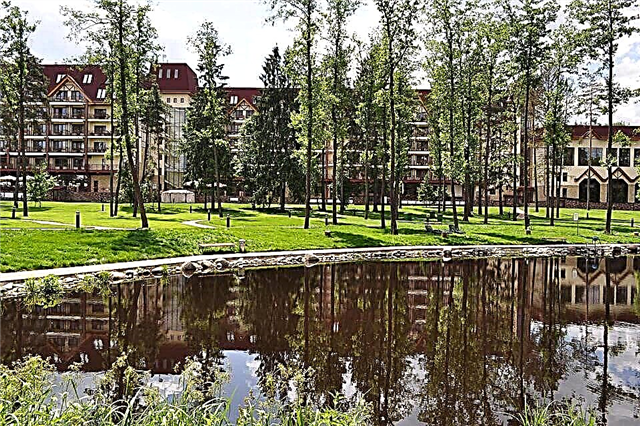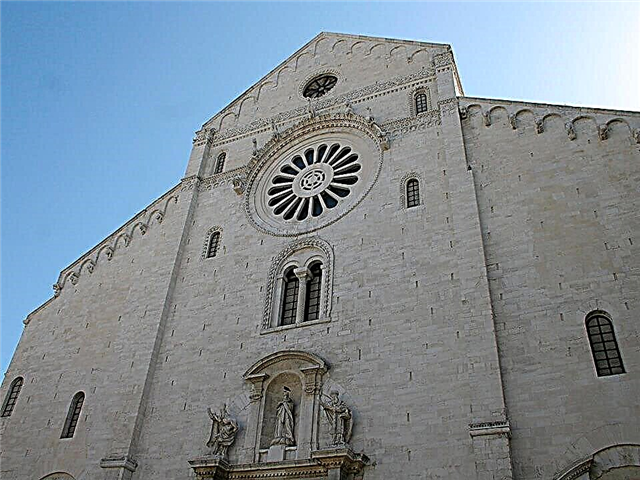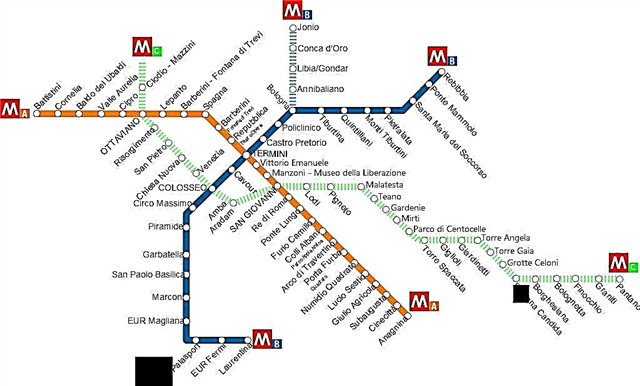The Vatican is one of the most distinctive states in the world. His secrets, his history, his income, his luxury and beauty - all this remains outside the focus of cameras and outside the eyes of the general public. Only a few halls, filled with the luxury of high culture and the gold of light, open to the world. These halls are the premises of the Vatican Museums, which have a fairly wide profile. But even acquaintance with such a "fragmented" splendor is already admirable.
Pia Clementine Museum

Undoubtedly, one of the most striking components of the Vatican complex is the Pia Clementine Museum. It was originally created as a place to store a number of artifacts representing Greek and Roman cultures. The first collections were successfully located on the territory of the orange courtyard that adorned the Belvedere Palace. However, the number of exhibits grew rapidly, and it was decided to create new "niches" for the most significant works of art. So, today the niches of Hermes, Apollo, Laocoon, Perseus and some others are open.
In addition to sculptures of gods and heroes of the Ancient World, there is also one of the richest collections of animal sculptures in the world practice. The Rotunda Hall recreates the splendor of Nero's Golden House in a creative reworking within the framework of ideal classicism. Particular attention should be paid to the floor of this room: it is lined with authentic Roman mosaics that forever capture the military prowess of the Greeks. Another hall is subordinated to the Egyptian theme: sarcophagi, frescoes, mosaics, statues of the third century and other objects of history and art.
Colosseum, Roman Forum, Palatine Hill with one ticket
Time entrance to St. Peter's Basilica with audio guide
Fast track entry to the Vatican Museums and Sistine Chapel
Borghese Gallery: Reserved Entrance Ticket
Skip-the-line: Museums, Sistine Chapel, St. Peter's Basilica
Rome: hop-on hop-off sightseeing bus tour
Rome bus ticket: 24, 48 or 72 hours
St. Peter's Basilica with Dome Climb and Crypt Visit
Chiaramonti Museum

Its founder was Pope Pius VII, who came from the Chiaramonti family. The collection of the museum includes reliefs, bas-reliefs, samples of portrait sculptures related to the classical culture of Greece and Rome. The first thing that catches your eye is the corridor, which is a colossal arched gallery, divided into sixty independent sections. The most significant artifact - from a historical point of view - is the statue of Athena, or rather the head of Athena of unprecedented size for that period. The complex of this museum includes three structures. The Chiaramonti gallery itself, which is the oldest component of the museum. The masters of the St. Luke Academy worked on its design.
The main decorator was the notorious Antonio Canova. Braccio Nuovo, or "new sleeve", is a relatively new section that houses exhibits representing the history of Rome and the mythology of Greece. It is here that the largest collection of portrait sculpture is located. Today, a visit to the Lapidarium gallery is carried out only on special request, since there are truly unique inscriptions from the pre-Christian and Christian periods, which are one of the most significant historical sources.
Gregorian Museum of Secular Art

The museum was founded in the middle of the nineteenth century. At that time, his expositions were located in the Lateran Palace. The basis of the collections was formed by artifacts of a secular nature, which were discovered during excavations at the beginning of the nineteenth century. After moving to the new premises, this part of the Vatican complex was opened to the public. Among the most valuable treasures are the statue of Sophocles - a brilliant copy of a bronze original of Greek origin, the statue of Neptune - a Roman tracing paper for a similar Greek statue, the head of Athena - a number of copies of Roman masters based on the work of Myron. It is also worth paying attention to the impressive number of sarcophagi, decorated with images of the gods and heroes of antiquity, as well as miraculously survived fragments of the Parthenon. Another interesting addition is the mosaics that used to decorate the baths of Caracalla.
Gregorian Etruscan Museum

The real pride of Rome can be considered the legacy of the Etruscans, a great civilization whose dawn came in the eighth century BC. It was they who created the foundations for the further development of ancient Roman culture. Today, household items of ancient people and pearls of their cultural heritage are kept in the former palace of Innocent III. The collection is based on artifacts found in the middle of the nineteenth century during excavations of settlements in the South of the country. Subsequently, artifacts from the excavations at Sorbo were added here, basically completing the formation of the museum fund. At the moment, guests can visit twenty-two thematic rooms.
Some of them are chronologically formed, for example, the Archaic Hall or the Bronze Hall. In others, certain aspects of the life of the Etruscans were recreated. So, today halls are open, repeating the entourage of Etruscan temples, tombs and treasuries. Many truly unique finds are kept here, such as a mirror on the surface of which you can see the face of the goddess, ancient oil lamps, numerous vessels for storing incense, as well as skillfully made glass products.
Gregorian Egyptian Museum

This part of the Vatican complex was discovered in the first quarter of the nineteenth century. The name of the museum retained the name of its founder - Pope Gregory XVI, however, in fact, the first drafts of the collections appeared under Pius VII. Egyptian culture is in many ways a reference, and therefore it is not surprising that samples of the works of the great masters of Egypt were protected by the Vatican. These are various death masks that were created for the pharaohs, and skillful busts, and numerous sculptures. To date, nine halls are open to the public.
In addition to the household items of the ancient Egyptians and various attributes that accompanied funeral ceremonies, the mummies of some pharaohs and steles with hieroglyphs are also kept here. A number of rooms are dedicated to finds illustrating the life of ancient Syria and Mesopotamia, whose civilizations were not much inferior to the Egyptian ones. In addition, it is here that there is a unique collection of ancient ceramics of Christian and Islamic traditions, also found in Egypt.
Picture gallery (Pinakothek)

Initially, the Pinakothek was understood as a certain collection of paintings that were donated to the glory of the goddess Athena. A little later, they began to call the premises in which samples of fine art were stored. A similar interpretation refers to the ancient Roman period. During the Renaissance, the Pinakothek began to refer to collections of paintings available for public viewing. The modern Vatican Pinakothek emerged in the early twentieth century to become one of the largest galleries of religious painting. Here are the works of the greatest Italian masters, from Giotto to the works of Crespi.
In the halls, in a strict chronological order, canvases and mosaics are arranged, consistently representing the art of the Middle Ages, Renaissance, Baroque and some others. Some of the internationally renowned creators will be familiar to the general public, such as Raphael, Cavaragio, Titian, Leonardo da Vinci.Some others - less well-known outside of Italy, will help you take a different look at religious painting. These are the works of artists such as Giotto, Ange, Criveli, Bernini.
Pio Cristiano Museum

The collections of this museum are collected at the expense of artifacts of the early Christian period, that is, they were all created in the interval from the second to the fourth century AD. Most of them were found during excavations in the Roman catacombs. The earliest collections were located in the Lateran Basilica, however, then they were transferred to the Vatican. The exhibition opened only towards the end of the twentieth century. Basically, the museum presents a variety of sarcophagi, which are decorated with various bas-reliefs, as well as drawings on antique themes. All of them are arranged in chronological order, and also grouped according to the principle of iconographic subjects.
Almost all the drawings are perfectly preserved and have not lost their aesthetic appeal, despite their more than solid age. One of the most significant exhibits is the sarcophagus of the Good Shepherd, which was supposedly created in the fourth century. The authentic look was not fully preserved - the sarcophagus, which is presented to the public today, is a version restored in the eighteenth century.
Ethnological Missionary Museum

The Lateran Palace at different times has become a haven for all sorts of institutions in one way or another connected with the world of creativity. The Ethnological Missionary Museum was no exception, which was originally located under its ancient vaults, and then was transferred directly to the Vatican, where a new building was built to store and display the collections. If the first versions of the collections contained about forty thousand artifacts, then today their number has already exceeded one hundred thousand objects that are collected from all over the world. The focus is on religious cults of various orientations. These are both long-extinct cults and cults that have only recently begun to gain strength.
Here are collected artifacts from Japan, China, India, Korea, Tibet, Mongolia, various African countries and even Oceania. Museum guests will be able to familiarize themselves with the specific features of various nationalities. The depositories are of particular interest to scientists and specialists who can visit the halls containing religious objects.
Vatican Library

The library, called the Apostolic, is perhaps the most important component of the Vatican's museum complex. This citadel of knowledge houses books dating back to the early Middle Ages, numerous manuscripts and unique manuscripts. The library was founded during the Middle Ages, but its funds continue to grow today. In addition to handwritten and printed sources, there are also numerous maps, an impressive collection of inculabulas, coins and medals. Unfortunately or fortunately, only a small part of the premises is open for most tourists.
However, it is unlikely that the broad masses would be able to appreciate the treatises in classical Latin, but the richness of the design is much easier to evaluate - for this reason many visit the Library of the capital of the Christian world. Frescoes of amazing beauty were created only by the most worthy masters of their craft. Scholars and students visiting this institution as part of their research work can see a wider range of exhibits. According to legends, the Library actually has a system of passages and secret rooms in which manuscripts containing answers to the most tricky questions of the universe are kept.
Historical Museum

It is really difficult to get into this unique building, since there are clear regulations according to which the number of visitors cannot exceed forty people. But the battle for the ticket will be worth it. The richest decor, bright exhibits, documents, icons, uniforms, photographs, household items, saddles, palanquins and even carriages - all these items help to immerse oneself more fully in the proposed historical era. All popes in the intricacies of political and interpersonal strife will appear before the eyes of visitors.
A talented guide will tell you how, what and why pontiffs of all times lived. Perhaps the most unusual are the following exhibits: a ceremonial carriage that belonged to Leo XII (it was this carriage that was used by the Pope for almost a hundred years), the first locomotive of the Vatican, dating from the beginning of the twentieth century, as well as the Popemobile, a kind of means of transportation used by the Popes when necessary. public travel.
Gallery Arazzi

This gallery is considered one of the three main galleries located on the territory of the Vatican Apostolic Palace. It was discovered in the last quarter of the sixteenth century. The main architect of this amazing building was Macherino. Shown here are tapestries depicting biblical scenes, as well as scenes from the Old and New Testaments. The sizes of man-made canvases are amazing. Only ten tapestries were able to fit within a hundred meters of the gallery, but their value is undeniable. Most of the plots are based on sketches and works by numerous students of Rafael Santi.
The almost undisguised hostility shown by the master towards those who tried to compare his work with the paintings of Michelangelo is reliably known. That is why on these tapestries one can clearly read his corporate style with exaggeratedly large figures in comparison with the landscape, deliberate emphasis of individual gestures and details, and a subtle play of accents. The tapestries were created by Flemish craftsmen from the Peter van Elst manufactory. Initially, these tapestries were kept next to Raphael's frescoes in the Sistine Chapel, however, they were later transferred to the Arazzi Gallery in order to appear before a wider public. The finest silk and wool, the viscous twilight of the premises, the quiet voices of the guides - it seems as if the colorful figures come to life and gaze intently at the guests of these vaults.
Gallery of geographic maps

The triad of galleries of the Apostolic Palace also includes a gallery of geographical maps. It took almost two years to create the gallery. The renowned sixteenth-century master Ottoviano Mascherino, who at that time was the architect of the Palais des Papes, was responsible for the architectural component of the work. On his initiative, the western wing of the Belvedere was expanded - practically by one floor. But the work done was necessary. More than a hundred meters of the corridor was painted from floor to ceiling with topographic maps of Italy. The age of the dawn of the papacy was reflected on the walls and ceilings, clearly limiting the Papal lands and the main city-states of Italy, which at that moment continued to wage wars open or barely noticeable to ordinary people.
In addition to purely geographical data, here you can see numerous references to historical events that took place at that time. Images of mythological characters, terrible sea monsters, heroes and beautiful ladies bloom on the stone. The masters did not forget about the pearls of the architectural world - the most significant places of their era also appeared on the walls. It is noteworthy that the hall is divided into seventeen sections. Naturally, the geography of Italy is divided into two components: one is washed by the gentle waters of the Andriatic, the second - by the Ligurian and Tyrrhenian seas. And above all this there are the Apostles and Saints, scenes from the Old Testament unfold.
Borgia Apartments

These apartments belong to perhaps the most notorious Pope - Alexander VI, who bore the name of Borgia. He and his family - the Spaniards on the Italian throne - went down in history for a long time with their exorbitant ambitions and methods far from righteousness.Therefore, it is not surprising that even after the death of Alexander VI, the subsequent governors of Christ were in no hurry to occupy the richly decorated rooms, turning them into a museum. The master Pinturicchio and the artists who were his students worked on the painting of the Pope's personal apartments. The halls that are located today in this kind of museum are named after the main motives of the murals.
So, you can visit the Hall of the sacraments of faith, which depicts the main Christian sacraments; Hall of Sibyls and Prophets, decorated with images of seven planets known at that time (it was here that the Pope's eldest son, Cesare Borgia, ordered the murder of his beautiful sister's spouse); The Hall of Saints, almost entirely designed by Pinturicchio himself; The Hall of the Pontiffs, which previously housed portraits of the Popes, which, however, have not survived to this day; Hall of Faith Wonders with sketches of the main religious festivals; as well as the Hall of Sciences, which is decorated with attributes of the free arts, sometimes depicted in an anthropomorphic form.
Raphael's Stanzas

Sadly, the need for Raphael's stanzas arose after the death of Pope Alexander VI Borgia. Hatred from the curia reached its climax, and the next Pope, Julius II, refused to live in the Borgia apartments. To decorate the new chambers, they invited the still young master Raphael, who recently turned twenty-five years old. He decorated the rooms with his students, filling each of the walls with frescoes that adorned them from floor to ceiling. Four rooms were decorated, however, the last of them is less known, since the master's students graduated from it after his death.
The Stanza of the Senyatura deed, the Pope's study, evokes the most delight. The main theme of the paintings is human mental activity. The most famous is the brilliant fresco "The School of Athens", which is considered perhaps the most striking example of Renaissance art. In the center of the composition are Aristotle and Plato, representing the materialistic and idealistic directions of philosophical thought, and around are the outstanding thinkers of their time.
Loggias of Raphael

This cultural monument belongs to the period of the High Renaissance, when the art of Roman classicism reached its peak. The architect Bramante developed the project of the loggia, from which an impressive view of the blooming Eternal City was to open up, and brilliantly embodied it. Raphael Santi, the chief decorator of this monument, was a close relative of Bramante, and it was he who took on the design of his creation. Pilasters, vaults, walls - all this was painted by Raphael himself and his students. It is noteworthy that his corporate identity is not felt in the design.
Numerous ornaments and repeating elements were inspired by the grotesques that adorned the "Golden House" in Rome. In total, more than fifty compositional elements of the painting were created. All of them make up a single composition and obey a single plan. So, Raphael's loggias are also called the Bible.











